Saab 32 Lansen. Head up
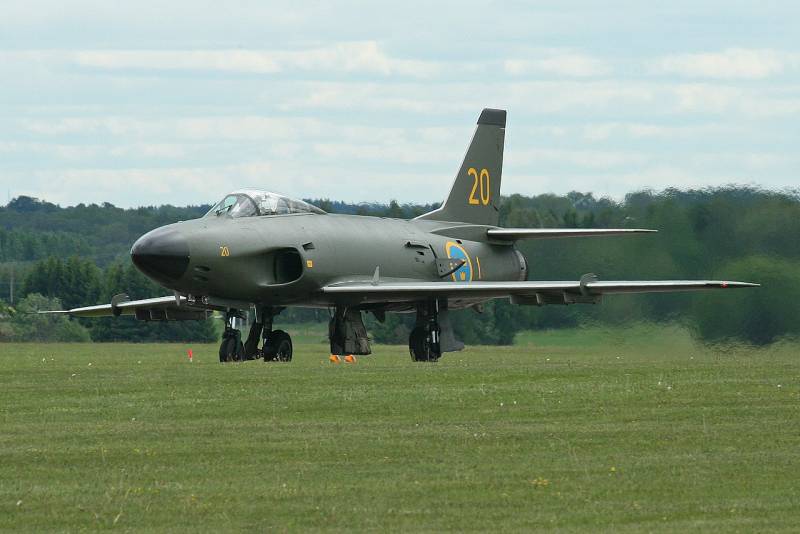
This is a sequel stories Saab 32, but this time the story focuses strictly on the Swedish fighter, as a full retelling of the context in which this aircraft was created was set out in a previous article.
After the competitive advantage of jet fighters was demonstrated in Germany, similar Messerschmitt Me 262 machines began to appear around the world, only easier to manufacture and operate. Sweden, which has ambitions for a strong aircraft industry, inevitably joined this race.
One way or another, for any country starting the process of creating its own jet aircraft, there were two fundamental problems: high cost and unpredictability. The concept of jet engines could already be called proven, but for Sweden, which had previously worked on the piston Saab 21, which, incidentally, would be converted into a jet aircraft in 1947, it was an unplowed field.
There was no experience in this industry commensurate with the experience of Germany, but there were projects from other countries, their developments and clear criteria that simply had to be implemented.
In order not to stretch the article any longer, we will do three things in a blitz format or how it will turn out: we will isolate the context that is worth keeping in mind; understand the criteria for the Saab 32; we will find an approximate design, based on the aircraft of other countries, and the requirements for the aircraft. Let's start.
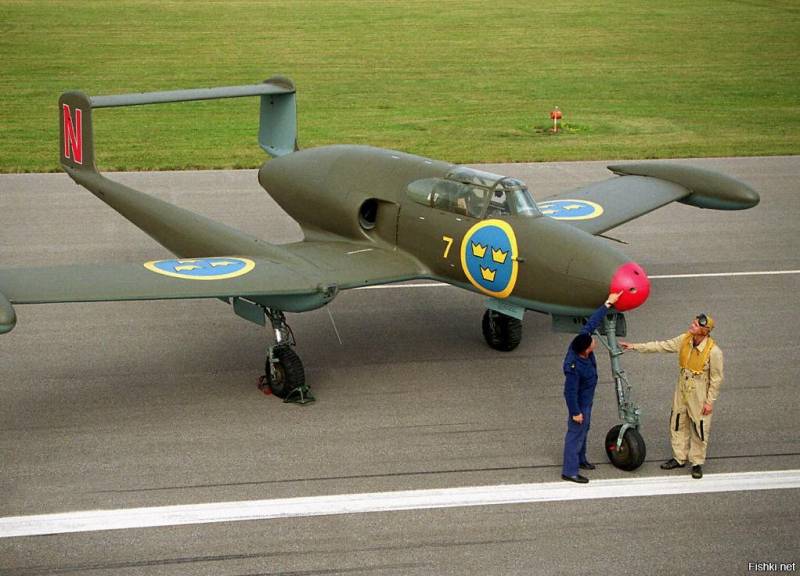
Saab 21R
Context
I will try to describe it as briefly as possible.
By the time the Saab 32 was developed, SAAB was the main force in Sweden, with a portfolio of orders, its own developments, experienced staff and knowledge of designers who worked in other companies, including German ones. The latter was represented by a large number of innovations in aviation, the main and defining of which was the active phase of creating full-fledged jet engines, which no longer looked like something from the primary German attempts created according to the rocket type.
Now there were full jet engines making a difference on the battlefield. Also already in Sweden itself there were developments of jet aircraft, which so far continued to be based on piston aircraft. The Saab 21R is a continuation of ideas from the design of the Saab 21 and Saab 29 - a jet machine that also drew on some German designs and the experience of colleagues from other countries, but already looked like a first generation fighter.
With this brief summary, we can continue to study the Saab 32.
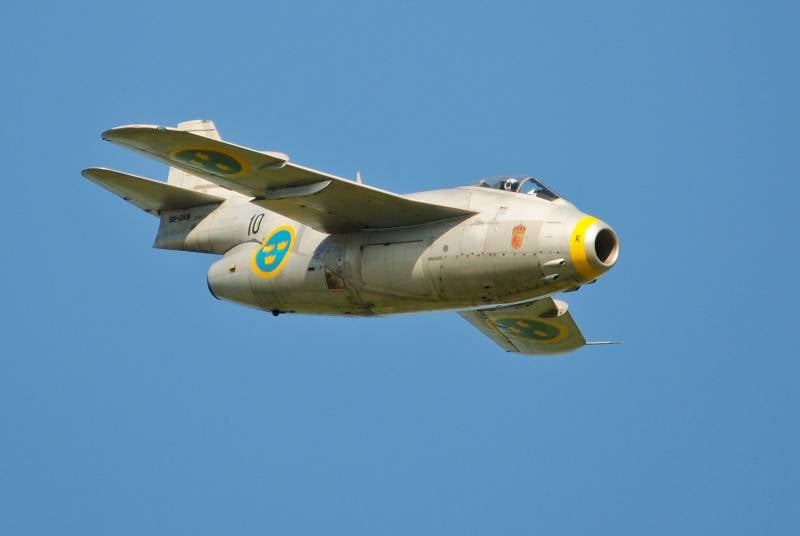
Saab 29
Tasks
Now let's move on to the topic of tasks.
In 1948, the Swedish government decided to turn to SAAB with the question of whether it was possible to create a single replacement for the Saab 18 attack aircraft (as the model range was called in general, specific models began with the letter index J (fighter), A (attack aircraft), B (bomber), S (reconnaissance) or T ("flying desk"), depending on the role of the aircraft (only the last three belong to the Saab 18)), the piston version of the Saab 21 fighter and attack aircraft (including the night fighter) and the de Havilland Mosquito.
The issue of the power plant could not even be discussed: not only was this technology the future of aviation, but on the basis of a piston engine it was impossible to create such a versatile aircraft, which, as we will see later, would have to meet very strict requirements.
In the best case, with the preservation of the piston engine, it was possible to make something like the McDonnell XP-67 "Moonbat", but the history of the latter showed that this business, albeit very interesting, was disastrous.
As a result, the primary and very general requirements for the aircraft were: the ability to be a reconnaissance, fighter, attack aircraft; be reactive. From this it was already possible to start dancing SAAB, since at least part of the activity had already been done - in the fall of 1946, the company, on its own initiative, considered the possibility of replacing the already outdated Saab 18. Yes, and write off the development of Saab 21R and Saab 29, which replaced part of the industry, not worth it.
Design
Let's move on to the design, or rather, to what should have become a design.
The most important thing is swept wings.
The direct one was successful on piston machines, and it showed itself better on takeoff and landing, but it is fatal when reaching supersonic, since even with transonic, drag increases greatly. So the Saab 32, for which transonic was a task, needed an exclusively swept wing.
What a sweep, I can’t say for sure, but by eye (!) About 55 degrees along the front chord. You should not believe my assessment here.
Next come the engines. Despite the disagreements in the company, which also offered the creation of a twin-engine aircraft, it was obvious that it would be easier and more profitable to create a single-engine aircraft.
Among other things, it was clear that we would have to use the classic engine layout, which is more difficult than the redan one, but will make the aircraft more promising. It was also decided to add two classic for our time air intakes on the sides of the cockpit, leaving room for the radar in the nose. Places for reconnaissance equipment, which was customary to install inside the fuselage, with this version of the airframe became smaller, but this situation did not become a Gordian knot because of this.
An option could be to borrow the solution used on the RF-80. There, cameras were installed in the nose, which, however, did not interfere with the missions that were required from the F-80. But such a decision was very difficult, and it was not known for sure whether the guys from SAAB could bring such a project. So it was decided to take the path of least resistance - just make an aerodynamic ledge under the fuselage, which would be enough to fit cameras into it.
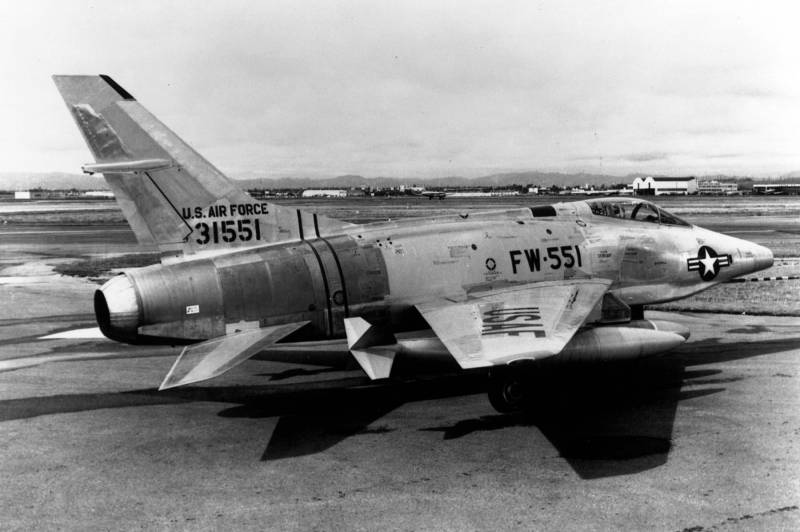
Something similar was later on the secret RF-100, some of whose missions have not yet been disclosed. In the future, on the reconnaissance version of the Saab 32, the fairing was equipped with 4 cameras for photo reconnaissance, two SKa 17 for photography from low altitude and two SKa 18 for photography from high altitude. Over time, the composition will change upwards: 1 × observation camera SK 15/150 mm, 2 × high-altitude camera SK 23/600 mm, 3 × low-altitude camera SK 16/100 mm.
It took a long time to find the optimal design. The exact designs of the first versions of the Saab 32 have not come down to us, but the names of those same models have been preserved: P-1100, 1108, 1114 and 1119. But only in December 1948 will the optimal design of the project be found, and with it the sketches. I will assume that the letter “P” here is an abbreviation for the Swedish word “project” (project), but what the numbers after the letter meant is a good question ...
With a high degree of probability, this was just a serial number within the company, since we know for sure that subsequent SAAB projects also had a four-digit index in the early stages of design. For this detail, we can thank the author of a brief biography, Aarne Lakomaa, about whom another time.
But only on December 20, 1948, when the requirements for the future fighter had already been determined and the optimal design for the project had been found, two events happened.
Firstly, the first stage of the contract for the design and layout of the project was issued, in fact, what we have just discussed with you.
Secondly, SAAB AB received funding due to this, which did not bode anything but optimism.
Also, the project activity that had begun had a name - P-1150, and the chief designer - Arthur Bresho - was introduced to the project. The future shock version received a special name - RA-1150 (Reaktionsmotor Attack - jet attack aircraft).
And yes, I did not tell you about the requirements themselves.
Requirements
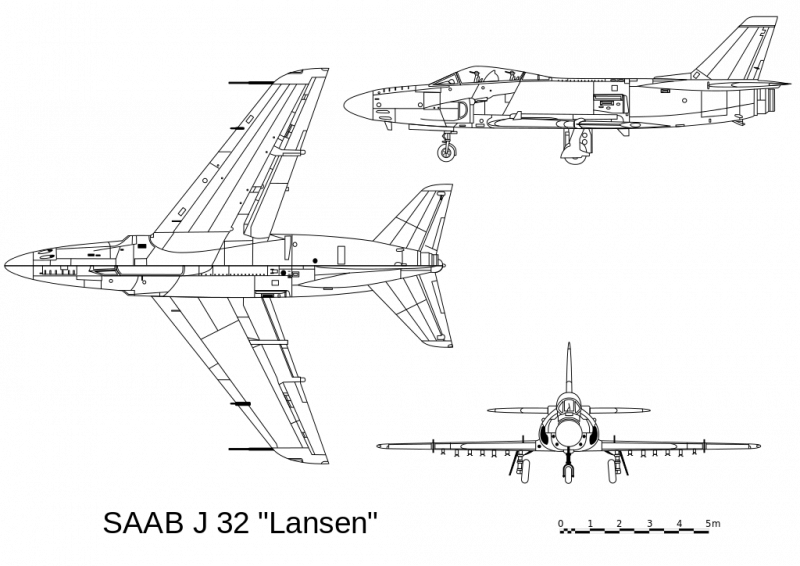
So, the P-1150 project was required to: attack any place along the coastline of Sweden with a length of 2 km within one hour after launch from a central point; have the ability to start in all weather conditions, day and night. Very demanding criteria for the aircraft, which, however, still distinguishes the Swedish military.
In response to this, SAAB AB take a rather logical step in such an introductory act - they make the aircraft a two-seater, with advanced electronics and a low wing. And if it comes to that, then yes, there was a radar on the plane, and, as follows from the leitmotif of the article, it was head and shoulders above everything that was before.
And we, fortunately, know exactly the name of this radar - PS-42 / A, and we also know the manufacturer and some of his chips. Well, firstly, it was developed by Ericsson, which is a classic and uncontested solution for Sweden to this day. Secondly, we know for sure that in the specifics of the combat use of the Saab 32, it was possible to conduct electronic warfare against ground and ship radars.
For this role, there was another complex, whose name we also know - G24. Thanks for this discovery, a museum piece from Spain that was once an Uppland Wing combat aircraft, or simply F 16, located at Erna Air Base, northwest of Uppsala, is to be thanked. The aircraft from this museum will be discussed in this article, as the author of the post about it illustrated the entire Saab 32 from nose to tail.
But we got ahead of ourselves, let's go back to the course of the program and see what else it took for the Saab 32 to become what it is now. Spoiler: here again there will be a lot of Germany, well, a little bit of Switzerland.
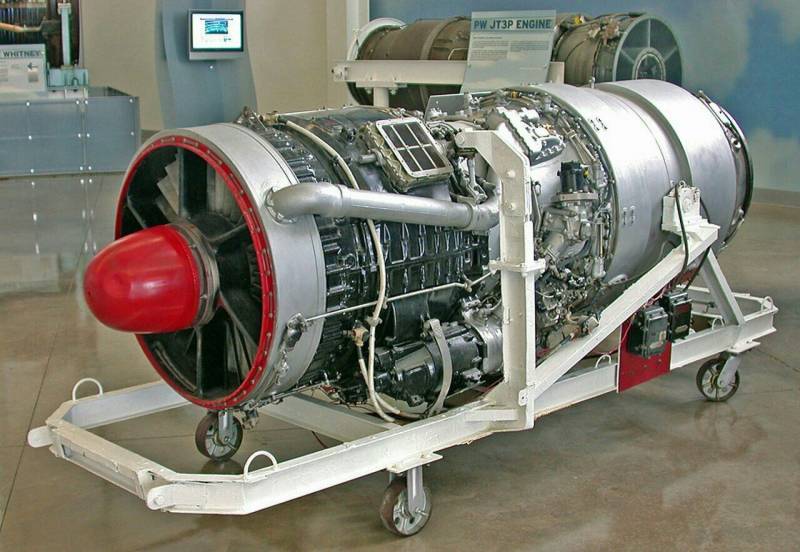
Rolls-Royce Avon
Engine
One of the first questions in the complex comprehensive creation of the Saab 32 was the search for an engine. The first option was domestic STAL Dovern engines, but their development was too shifted to the right, so much so that it was already being developed as an engine for the Saab 35, which was already a conditional replacement for the Saab 32.
The engine needed to be changed. But now the Swedish government (which, by the way, was officially known as the State Council of the King) decided to use foreign products. They chose a very popular British engine, which will later appear on the Saab 35 - Rolls-Royce Avon.
In total, about 11 of them were built for aircraft such as the English Electric Lightning, CAC Saber (Australian version of the F-000), de Havilland Sea Vixen and Saab 86. The version that was installed on the Swedish fighter was called the Series 32 and was assembled at the factories of a little-known Svenska Flygmotor AB, which was part of SAAB back in 100. Yes, this is how small the world is. But you will probably be even more surprised to learn that in the aforementioned year this company did not just become separate, but was bought. And the company that bought this asset is interesting - Volvo.
Yes, one of the most famous automotive manufacturers was the founder of jet engines for the first jet aircraft in Swedish history. Right now, by the way, Volvo continues to produce engines for the current Swedish fighter Saab JAS 39. The model that Volvo produced was called the RM.5 (A1 in our case), and it was with an afterburner. The data of the engine were serious: the thrust-to-weight ratio was about 0,3; 3 460 kgf without afterburner; 4 445–4 700 kgf with various afterburners. The maximum load capacity has increased by about 5 kilograms.
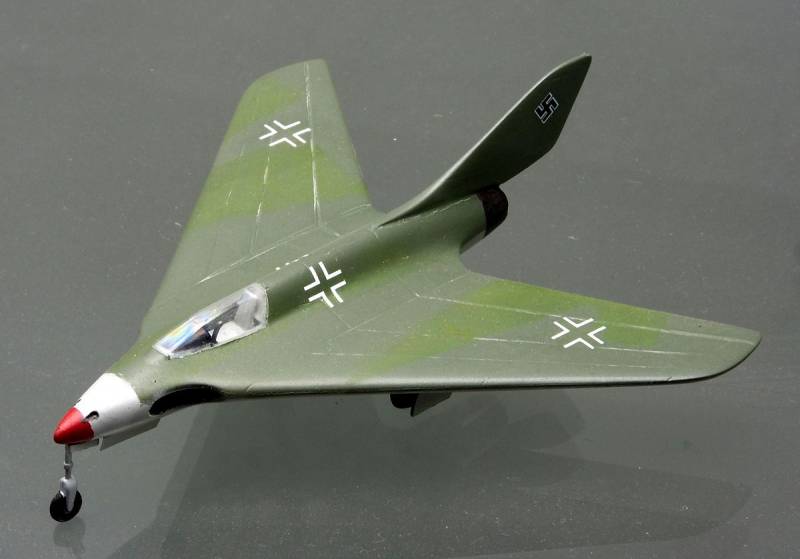
Messerschmitt P.1111 as an example of an Emegrecy Fighter Programm
Little things
Now let's move on to the details in the design and a little more explanation of the dominant decisions.
Well, firstly - swept wing. Yes, you and I have already understood why it was added to the design, but let's look at it more broadly, using the already mentioned data from Nazi Germany and Switzerland.
In general, there was such a person - Fried Wansterm, head of the SAAB accounting department, and there was also such a country - the Third Reich, in which there were a lot of innovative developments directly related to the Saab 32 project. For example, P.1101, P.1110, P .1111 and P.1112 (by the way, half of these fighters were part of the Emergency Fighter Program), which were developed in the leading aviation company - Messerschmitt.
In addition, as you and I remember, design activities did not end with drawings only, and Germany had both the first rocket aircraft and the first jet aircraft, which gave a huge impetus to the development of the entire industry. But the aircraft indicated above ended their fate on the drawings of odious and ambitious aircraft designers, which would subsequently affect the history of the Swedish aircraft.
To be brief, after the Second World War, scientists, engineers, pilots, or simply accomplices of the Nazis began to actively flee from the camp of the defeated, or rather defeated, country.
There were many destinations for fugitive, most recently important people to settle there. Argentina, in which Juan Peron ruled, who called the Nuremberg Trials "the greatest injustice that history will not forgive", or Spain, where another fascist Francisco Franco ruled, the Western part of Germany (it's up to your taste which zone of occupation, anyway, they will soon will merge into a single Trizonia), in which you would also not be disturbed, yet communism was more terrible, or even the United States, which could even help you using Operation Paperclip.
But the fugitive aircraft designers from Messerschmitt decided to settle in Switzerland, which remained neutral in both world wars, but at the same time was armed with as many as 129 Messerschmitt Bf 109 fighters, which could be a good airbag for the escaped engineers. But once in the country of cheese, banks and watches, documents with very valuable developments were bought.
Yes, it was Freedom Winsterm. In addition, to the core of SAAB, and accordingly to the development of the Saab 32, the German Hermann Behrb, who since 1937 worked at Messerschmitt in Augsburg, in the aerodynamics department, was introduced. Under his leadership, the development of Messerschmitt Me 262, Messerschmitt Me 163 and Messerschmitt P.1101 (yes, the one that was part of the project activity that went to Switzerland, and then to Sweden) was carried out. The latest project, by the way, is very similar to the Saab 29, MiG-15, F-86, Dassault Ouragan, which, as I said, was normal for the first jets.
Admittedly, the situation at SAAB is developing remarkably - there is documentation and there is an author of the documentation. From this, you can not only dance, but with a light hand turn it into a base for creation, because now there is practically nothing to prevent this. As a result, already on October 8, 1949, SAAB will report to the state, receive the go-ahead to start preparing drawings for a production aircraft, and the project itself will acquire a new name, which is getting closer and closer to its final incarnation - Flygplan 32 ("Flight Plan 32") . True, there was still a lot to work out, for example, again and again - the wing.
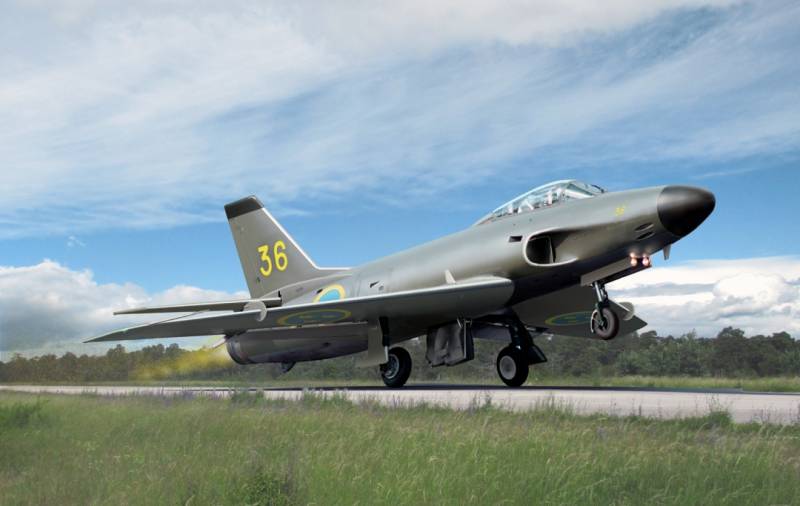
Various decisions were made to work out the future wing, for example, since 1950, tests of the P-1150 mock-up with missile mock-ups under the wings have been carried out in wind tunnels. But now let's look at the practical tests of the wing, which will later be installed on the Saab 32. “Theory without practice is a backpack with swimming textbooks behind a drowning man” (Dmitry Yemets), and it was obvious to the Swedes, so trying to test all their ideas before the development of the test boards of the Flygplan 32 itself, was already done. For this task, a special aircraft will be created, which was called the Saab 202.
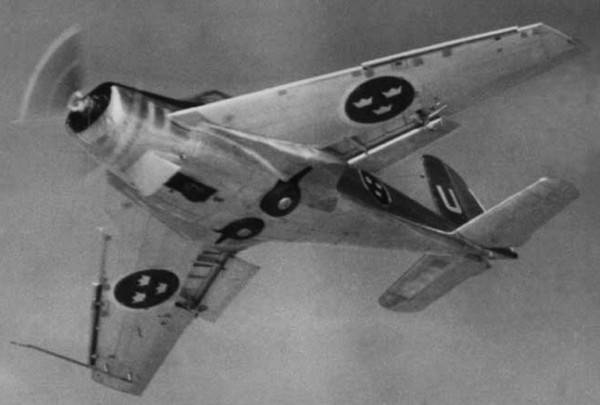
Saab 202 (or 201)
Here you can immediately see the pragmatism of the Swedish approach to aircraft construction and the continuity of generations with the previous jet aircraft from the Viking successor country - Saab 29 Tunnan. The fact is that during the development of this aircraft, everything had to be checked for the first time. It was not clear how the swept wings, mechanization, air intake, and the jet engine itself would behave.
Of course, there have already been fighters similar to the Saab 29 in the world, but the data for such projects needs to be verified by yourself, which, in fact, happened. As a flying laboratory, they chose the recently taken off piston Saab 91 Safir, which, by the way, was developed by our longtime hero Ander Johan Andersson. The new aircraft, called the Saab 201, was given swept wings and new mechanization, and then began testing.
I note that the plane looked very stylish with such wings, but in normal operation they would be more likely to harm the car. The tests lasted several months from 1947 to 1948, which made it possible to work out many important details of the design, thereby accelerating the creation of all subsequent Swedish aircraft, including the Saab 29. Indeed, already in September 1948, under the leadership of pilot Robert A. Moore, the first prototype Saab 29 for the first time off the ground.
Some time after the tests of the Saab 201, active design work on the Saab 32 began, and the Swedish "monster plane Frankenstein" was again awakened from sleep. This time it was used to test airframe parts that will be installed on the Saab 32. In order for the flying laboratory to be at least a little closer to the future transonic fighter, a new, more powerful engine was installed on the Saab 201. And what was extremely important in this case, they changed the name - now it is Saab 202. Due to such tests, it was possible to check the low-speed characteristics of the airframe of the future Saab 32, which had an impact on the development of Saab 32.
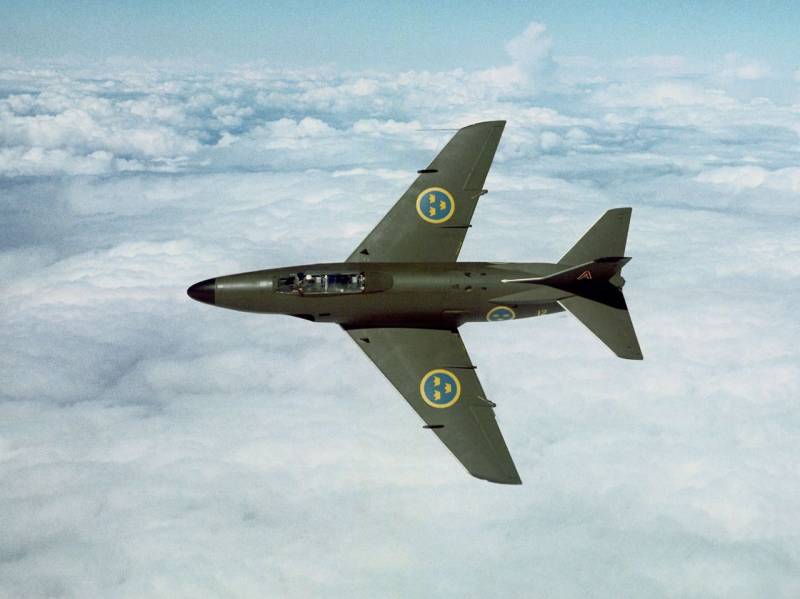
We summarize the
With the help of tests on another aircraft with a piston engine, a sufficiently large layer of solutions that will be applied to the Saab 32 was tested and did not cause more questions or disputes. With such a store of knowledge, SAAB now had a far from illusory task that could not be solved.
Yes, and it would be strange, having the documentation of the Germans, excellent aircraft designers, clear tasks, ready-made developments, tested ideas, own experience in the industry, not to be able to cope with the creation of a jet fighter-bomber with reconnaissance capabilities. Of course, the speed, like other characteristics, of the aircraft could still not suit the military, but having such competencies behind them, the likelihood of this was very, very small.
But now a new question - what else needs to be done? That is, really, what else did the SAAB aircraft designer need to work out for the first flight of Flygplan 32? The project may turn out to be innovative and difficult, in terms of the tasks assigned, but the aircraft that this project should replace are already becoming obsolete, and rapidly.
Aviation is developing by leaps and bounds, the similar De Havilland DH 112 Venom and Hawker Hunter have already set off on their first flight, and Flygplan 32 is still just developing, although it’s time to go on the first flight, and you look at the plane and it may even turn out to be pointless. And indeed, now even the relatively modern Saab 21R at the time of its creation seemed to be lagging behind in all directions.
This was understood by both aircraft designers and the military, supplementing the list of aircraft to replace the Flygplan 32 with the aforementioned first Swedish jet aircraft. And according to Saab 29, no one had any illusions - the plane will soon, or rather, quickly, become obsolete. This means that a fundamentally new replacement is needed to a greater and greater extent - there can no longer be any talk of delays.
In any case, they were, and there will only be more global ones, and little could be done with them, because by 1950 mass production of Saab 29 fighters had already begun, and in total, as many as 1951 such fighters would be built from 1953 to 224 in version J 29A. It was already pointless to give the contract to any other company, too many resources were put into Flygplan 32, so the only possible way was to continue to wait for the test flights of the messiah for the Swedish Air Force, I apologize for the excessive pathos.
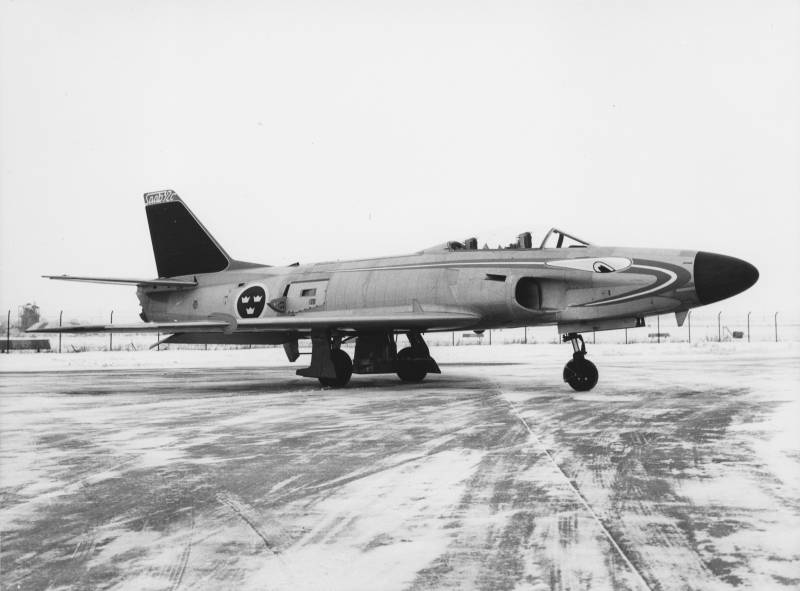
But everything ends someday - the waiting process also ended, because in 1952 the first prototype called 32-1 was built.
This aircraft, like most of the first prototypes, was still far from a serial model - it still did not have weapons and an afterburner, without which one could only think of entering transonic in a dive. But on the other hand, it had Fowler flaps, just like on the Airbus A300, and a slot in the leading edge of the wing. True, neither the first nor the second will appear on production aircraft, because more elegant solutions were invented, which let's talk about in terms of design.
Nevertheless, there is a flight model, which means the imminent start of runs along the airstrip, ground tests, the first flight and R&D. And finally, after the actual 6 years of work (although the design activity can be regarded as 4 years of work), the Flygplan 32-1 finally made its first flight. It happened on November 3, 1952 under the guidance of test pilot Bengt Olowa, who had worked in the SAAB system for almost his entire life. But this is only part of the story, because new prototypes are needed, with full-fledged equipment, which will be used for a long and responsible R&D process.
So, the already operating aircraft of Sweden were outdated, and their practical work on replacing them was not enough to fail. Of course, this will not happen, it could not happen, too much has been done to create Flygplan 32, but here are some R&D facts that show us that such fears could exist ...
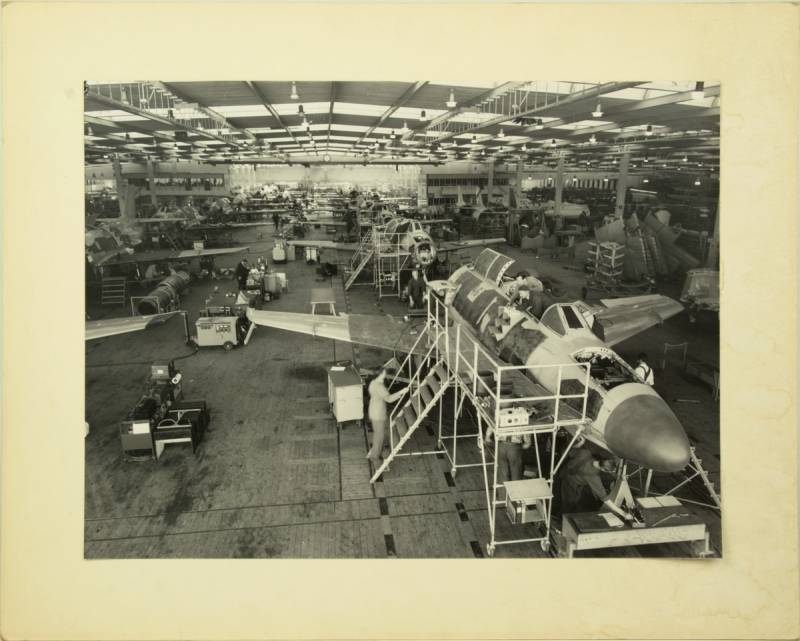
So what actually happened?
Nothing really, just a new prototype was prepared, Flygplan 32-2, which started its first flight. True, this “nothing” hides the time frame for which the second prototype of the future Saab 32 was made - a whole year. Yes, that's how long it took SAAB to create the second flight prototype, subject to the availability of drawings, the previous flying prototype, which could be used as a layout, teams, production, financing, competencies, tasks ...
I won’t argue, in this context, it’s not worth forgetting about the Saab 29 production process that has begun, which prevails over the production of flight prototypes for the Flygplan 32 project, but the project that was given to SAAB back in 1949 was also important, because without it the Air Force became completely incompetent, relative to neighboring countries. In fact, the Air Force had only one strike aircraft that could still be used as an argument in modern warfare - the already mentioned Saab 21R many times.
But it was not ideal either, because the creation of jet aircraft based on piston aircraft is pragmatic and correct, but only at the initial stage of development, and all other countries that were generally engaged in the jet aircraft industry have already taken a step forward. Yes, even Sweden stepped forward with its Saab 29 interceptor fighter, but their strike aircraft are outdated by at least a generation of jet fighters that are conquering the industry all over the world.
Fortunately, the second prototype was generally created, and he began to fly. The Flygplan 32-2 took off on December 15, 1953 and was already armed, which expanded the range of possibilities during R&D for engineers, but there was still no afterburner, which, on the contrary, was a problem when working on the Flygplan 32.
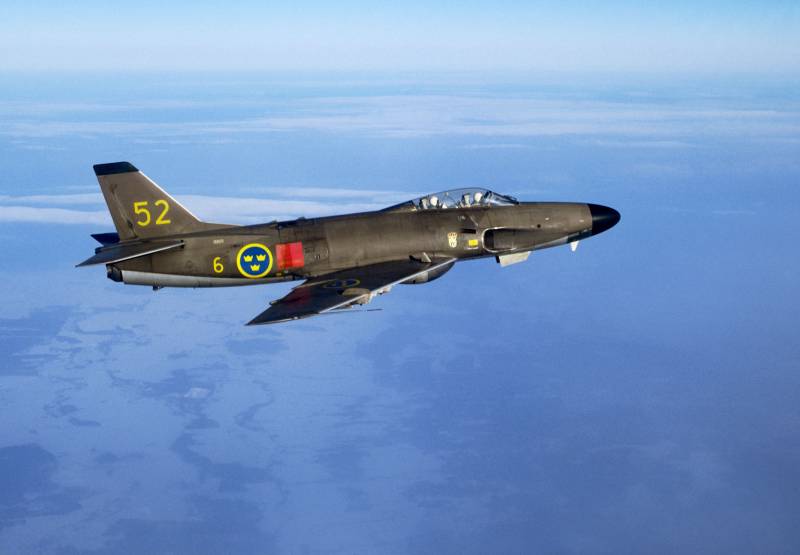
By the way, since we are in this part of the story, we should note that the Saab 32 is the first supersonic fighter in service with Sweden. Although as supersonic, as the first ... This fact is taken from the English version of Wikipedia, and the date of this first supersonic flight was even given there - October 25, 1953, but you already understand that everything is not so simple here.
Firstly, at that time there was only one prototype, which did not have an afterburner. Of course, the plane could enter into a dive, but this would not be enough to hear the supersonic boom. And what was needed was an afterburner, which would appear only a month later on another flight model. Although keep in mind with this kind of theorizing the word "probably". But in the paragraph "secondly", let's deal with the evidence, which is so strange that I don’t even want to comment on it.
No, there is not a broken link or one that simply takes you to another site, as happens with the page about the American A-67 attack aircraft, by clicking on which you will be taken to a site with slightly different, but of course also interesting content (Japanese site for adults to reject any allegory). In general, in order for us to check this fact on Wikipedia, we are offered to buy a book that is not in the public domain. Absolutely not. And I don't mind reading a book about aviation, but the book is not delivered to Russia.
However, such an undoubtedly important fact in the history of the Saab 32 is not in the Swedish article about this aircraft. And in general, only the authors of the book Jet Bombers (Osprey modern military) know about sensations about supersonic flights in a dive without afterburners, such sacred knowledge is not open to everyone else. However, I will not hope that this was not the case. I haven't read the book, because even if I could buy the book, I wouldn't pay $12 to double-check one fact for my article, so maybe there really is something there that will make me doubt the voice of logic and knowledge of dates .
Be that as it may, SAAB was still required to close the gestalt and finally create two more prototypes - one with an afterburner and weapons, and the second being already a pre-production vehicle. This time, prototypes were not created within a year, because already on April 15, 1954, the Flygplan 32-3, equipped with weapons and an afterburner, went on its first flight, which completely untied the hands of R&D. A little later, although it is not specified when exactly (but also no more than a year), the last prototype under the Flygplan 32 program, Flygplan 32-4, went on its first flight. In fact, it is already a serial board, which was even built according to serial drawings.
Now the easiest part of the development of Flygplan 32 has begun - to agree on the start of serial deliveries. It is difficult to describe this, because mass production has been expected for a very long time, what project should be known for a very long time, the financing of the program began a very long time ago, the finished pre-production aircraft appeared not so long ago, so there were hardly any questions. Moreover, there were no problems during the tests, and there were already ready-made drawings for development, which meant that there were no additional expenses for an already protracted project in all respects.
A spear
So the serial development of a new Swedish aircraft began, it now received a name that was built into the general scheme with other Swedish aircraft and, in addition, a proper name - Saab 32 Lansen (Spear).
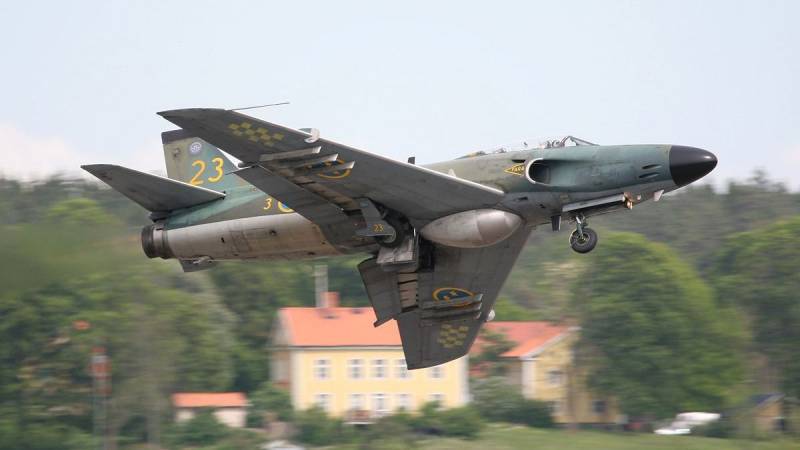
It is interesting to know which class was the first at the start of mass production of the Saab 32 Lansen.
As you and I remember, the primary goal, purely mathematically, for the Saab 32 Lansen project was attack aircraft. In fact, there were only two J 21 and J 30 (de Havilland Mosquito) aircraft in the fighter aircraft, and only one S 18 for reconnaissance. The Saab 29 Tunnan was both a help and a difficulty, because it performed the task of replacing fighters and reconnaissance aircraft, very soon he himself will have to be changed, which will also be on the conscience of the Saab 32 Lansen.
On the other hand, the list of attack aircraft that the Spear was supposed to replace was slightly larger: B 18, A 21 and A 21R. The problem here is that the aircraft from the abstract list for replacement in the bosom of strike aircraft were older, especially the B 18, and their replacement was required many times faster. Moreover, the replacement for fighters from the Swedish Air Force in the short term was the Saab 29, and there was no need to demand anything there to the extent that it was in the bosom of the strike force. We came to the conclusion that at this stage it would be more important to create a Saab 32 Lansen attack aircraft, and not a fighter.
The first order for the A 32 was placed by the Aviation Administration on 29 May 1953 for 64 aircraft. This was followed by 3 orders for a further 236 A 32As, 116 on August 22 of that year, 60 on September 3, 1954, and 60 on July 17, 1956. A total of 300 A 32A were ordered.
Saab 32 in the fighter version between 1958 and 1960, 118 copies of the J 32B were produced. They received serial numbers from 32501 to 32620 and were initially distributed between the F 12 and F 1. Finally, the reconnaissance S 32 Södermanland Air Fleet (F 11) in Nyköping began to receive in the fall of 1958. On May 15, 1959, when the last of the 44 S 32s was delivered to the F 11, the rearmament was completed.
Over the entire period of operation, 450 Saab 32 aircraft in all modifications were produced. Not the highest figure for a fighter of that time, especially a universal one, but for Sweden, provided that the Saab 32 was not produced anywhere else, this is a good indicator, taking into account how long the process of creating this machine was. This, unfortunately, is the norm in the aviation of any country.
But in terms of fighter aviation, there is one very important clarification, without which the story will not work out.
Qualification
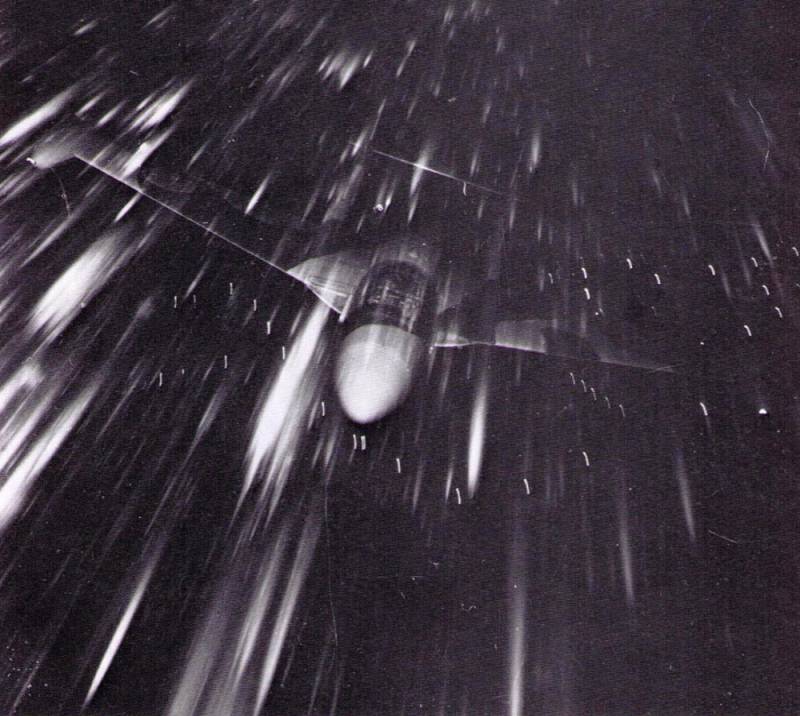
J 33
From the entire Saab 32 Lansen program, a considerable number of replacement aircraft were required from the very beginning of the ideas. But now another one has appeared - J 33 - de Havilland Venom jet night fighter. Initially, our today's hero was a replacement for the previous night fighter in the Swedish Air Force - the previously mentioned J 30, but the fleet of already obsolete piston aircraft required replacement much earlier than SAAB could offer. In this regard, in January 1951, the seemingly redundant J 33 was purchased from the RAF, and therefore the supply of Saab 32 Lansen fighters was shifted to the side, and priority was given entirely to the production of A 32A attack aircraft.
As a result, by 1955, the SAAB production vector was changing from the Saab 29 to the Saab 32 Lansen. Closer to December, the Swedish aircraft manufacturer makes a New Year's gift to the Air Force of their country - the first serial A 32A. This makes it possible without a second thought to abandon the piston B 18, which needed immediate retirement like no other.
Now a rather long period of production of the Saab 32 Lansen has begun, from its reconnaissance versions, which were produced in total in the amount of 45 cars, to the fighter versions, which were built in the amount of 140 cars, and the attack ones, which in all modifications became the most massive version of this aircraft - 287 cars .
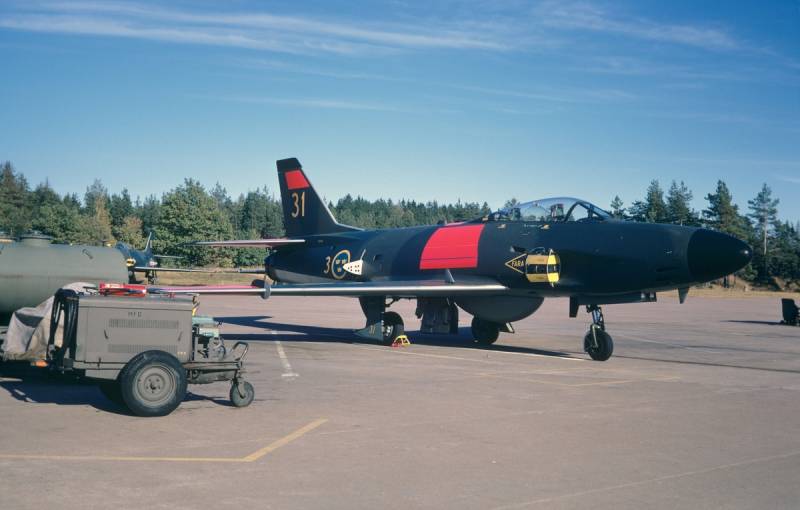
Each version of this aircraft can be described separately and for a very long time. But it would be strange to dwell on each modification separately and describe them in detail for a long time. And since I don’t see much difference between them, except for weapons and features in avionics, of course, then let’s later, when it comes to the design, make this mandatory part a little larger and try to describe the features of these modifications, but in a shorter format.
Instead, although it would be more correct to say “in addition to this”, because with such additions we are already at the very end of this long article, let's talk about various interesting modifications of this aircraft, because the Saab 32 Lansen, fortunately, did not have time, or rather - could not take part in real hostilities, but there were a lot of ideas on how to use this aircraft in them. For example, the delivery of nuclear and chemical weapons. Upon learning this, I was, shall we say, discouraged.
Of course, I heard about the development of nuclear weapons in countries where it seems completely pointless, for example, in South Africa, but Sweden ... However, as always, this had, or rather, still has, its own interests, but in that moment it was dictated by some tension hovering in the world. Indeed, even at the time of the Second World War, when, as we remember, Sweden did not deny itself cooperation with the Third Reich, large deposits of uranium were found on its territory. And the development of atomic bombs did take an active phase, and the interest in such deposits from Britain and the United States was huge. Sweden strictly said - "no".
But at the same time, there was also fear of the USSR, which was developing its program to create atomic weapons. But no one was going to create strategic weapons, and design activities were carried out strictly on the development of tactical defensive nuclear bombs. The carrier aircraft chosen for this was a Saab 32 Lansen, although there were two English Electric Canberras in service, which were used for a similar program in South Africa. But, fortunately, nothing further than interest and general analysis from the Swedish scientists followed. True, we were left without an amusing aircraft, like the Dassault Mirage 2000N/D.
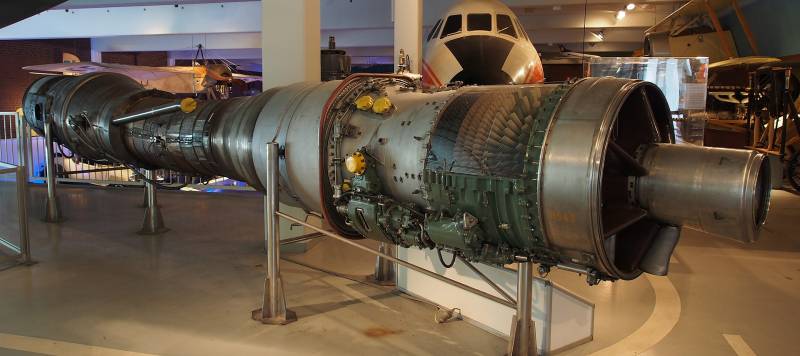
Planned engine for the A 32D
Other, but more mundane versions of this aircraft were also proposed. First of all, an all-weather version of the assault version of the Saab 32, called the A 32D.
The story is like this. In 1965, the modernized A 37 attack aircraft was proposed as an alternative to the Saab 32 Viggen under development. Armament was to consist of four stationary 30-mm ADEN automatic cannons, aerial bombs, strike missiles and tactical air-to-surface missiles such as Robot 05. Rolls-Royce Avon, modification Mk 60 (RM6 C) was preserved as a power plant. As a result, this attack aircraft was never built.
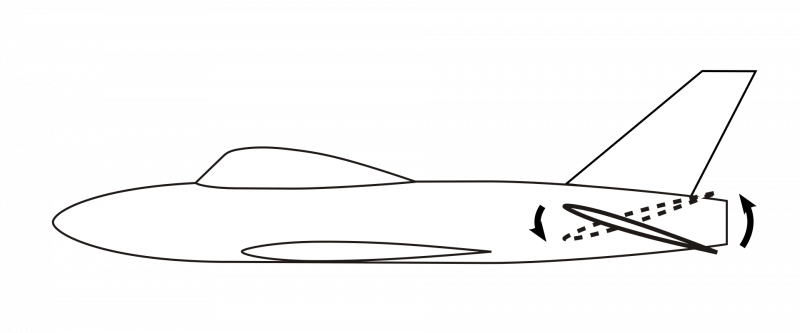
Schematic representation of J 32U
Another interesting modification was the J 32U, an all-weather fighter, an alternative to the J 32B since 1954 under the name J 32U. Unlike its predecessor, it was already supersonic (1235 km/h), meanwhile retaining the Rolls-Royce Avon engine, but in the RA.19R modification with a power of 5 with an afterburner. Significant improvements in the aerodynamics of the aircraft compared to the J 669B were supposed, which would allow the aircraft to be controlled at supersonic speeds.
Narrower keel and wings, and all-moving stabilizer. 6% narrower wings with a 40 degree sweep. Rocket boosters have also been proposed. Remained an option until 1958 as a future replacement for the J 32B, but was dropped due to the fact that the J 32B could be used for another 8 years and then replaced by more technologically advanced machines.
The last version of the Saab 32, which included significant changes to the latter, was the Saab 1160 or J 32AD - a single-seat version of the fighter without radar, created for day missions - a proposal in 1953 to replace the J 29 Tunnan. Missiles and tactical missiles were also planned as weapon options. It was never built, instead a British Hawker Hunter was purchased.
Now let's jump from the beginning of the Saab 32 Lansen era to its very end, or rather a little further. Right now, absolutely all Saab 32 Lansen are out of service, but back in 2010, only two "Spears" continued to fly in the skies of Sweden. A new challenge for them was to collect air samples from high altitude, as part of a collaboration with the Swedish Radiation Safety Authority. In the same year, the General Defense Research Institute used it to verify and update their computerized data on atmospheric volcanic ash. For this purpose, special tubes were installed on the decommissioned Saab 32 Lansen from the underside of the wings.
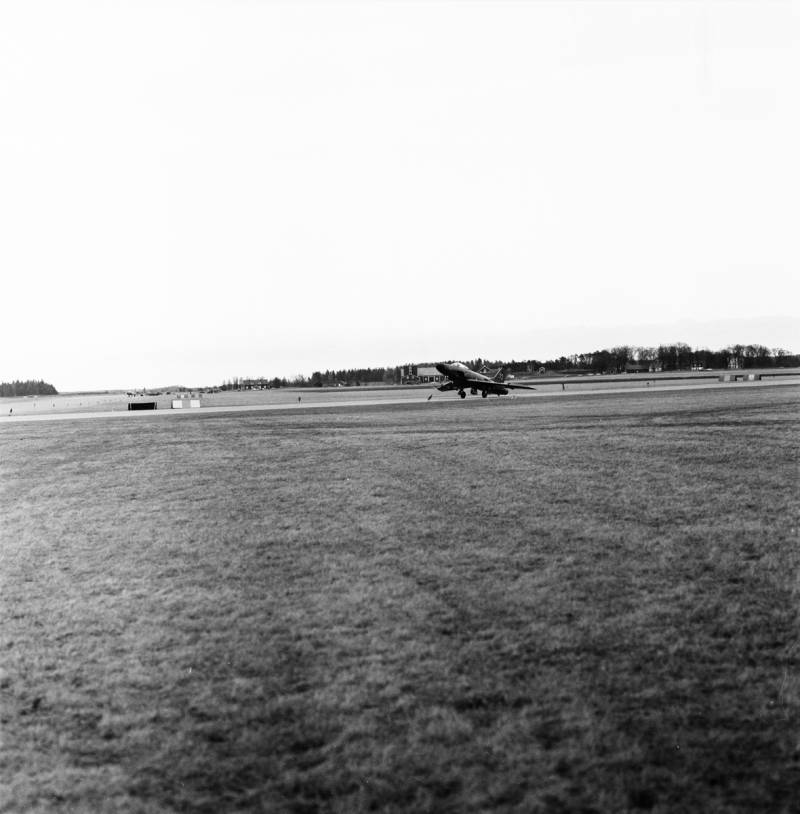
Another interesting task for Spear, but much earlier, was the collection of information about the explosion at the Chernobyl nuclear power plant, which happened on the night of Saturday April 26th. As everyone probably knows, not an illusory fear was then experienced by all the countries of the Old World, and not only the USSR, because if the approach to the accident had not turned out to be what it turned out to be, a local catastrophe could become global. But the heroic actions of the liquidators, who gave their lives for the lives of millions of people, did not allow this to happen, and now we can live the way we live. It is a pity that this cannot be said about many liquidators who fell under the millstones of restructuring, optimization and other joys of the "saints" of the 1990s.
In any case, in order to understand how much the explosion at the 4th power unit had an impact on the Scandinavian Peninsula, aircraft were needed, moreover, quite economical and high-altitude ones. Norway was most concerned about this issue and it was on its initiative that several Saab 32 Lansen were transferred to the needs of the Norwegian Institute for Radiation Protection. Their role was the same as they will be in the future - the measurement of air parameters.
Having found out that the problem was not yet as significant as previously thought, flights for the needs of the Norwegian authority ceased. Actually, no deliveries to other countries, except Sweden, Saab 32 Lansen followed during its production - the aircraft remained a local history. A fairly logical course of history, stemming from a long process of creation and a lot, if not huge, competition in a market in which the Saab 32 Lansen was not the most economical or most technically advanced aircraft.
Generation
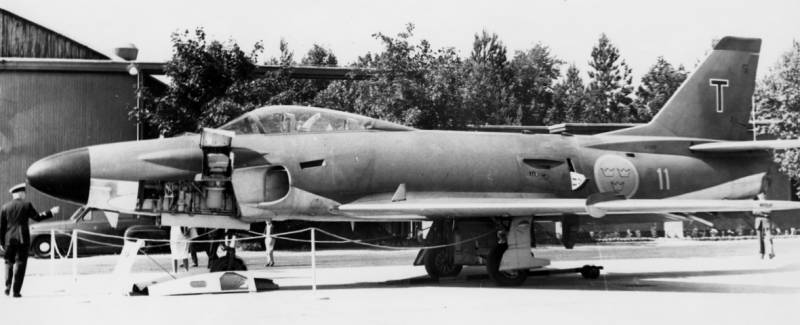
And finally, the last thing worth discussing before talking about the design of the aircraft is the generation. In fact, there is not much controversy about the belonging of the Saab 32 Lansen to certain generations. Perhaps because our today's hero is a fairly local aircraft, unlike the MiG-15 or F-86, and in Sweden, apparently, they also do not really want to argue about the generation of this aircraft. Although I may be wrong, I do not presume to judge. In any case, there is no clear definition of which generation this particular aircraft belongs to.
On my own behalf, I will say that a clear delineation of aircraft by generations up to 4, after which a more strict division began, up to 4+ and 4++, is not very correct. Not only because the division into generations, in principle, does not correspond to the logic of the development of aviation, we recall the F-15SE and KF-21, but also because even within the framework of this kind of division there are significant flaws. For example, I can understand that the Yak-15 and Saab 21R belong to the zero generation, but already by the first generation, without additions about the pros, sheer stupidity begins.
For example, I can understand that the MiG-15 and F-86 belong to the first and only the first generation, because they were the first jet fighters that turned out to be competitive with piston-engine fighters not only in scientific terms, but also industrially. And I can understand that the Saab 29 Tunnan belongs to the first generation, because it also meets the criteria for this generation, although it is not clear who invented it. But how the MiG-17 and the Messerschmitt Me 163 (!) exist simultaneously with these aircraft, it is absolutely unclear to me.
But since all Century Series aircraft belong to the second generation, and also the MiG-19, Yak-28 (which is primarily a bomber, and only then an interceptor (it is strange that then the Su-15, Tu-128, MiG-25 and MiG- 31 is not usually attributed to any generation, if the Yak-28 is an interceptor and belongs to the generation of fighters)), Dassault Mirage III and Saab 35 Draken, then yes, the MiG-17 and Saab 32 Lansen are definitely first generation aircraft. True, then questions arise already about the exact belonging of the two above-mentioned aircraft specifically to the first generation, because a step forward relative to earlier developments and countries cannot be overlooked.
And this is what I want to convey, that it is very strange to divide fighters into generations like this, because they have similar qualities due to innovations in aviation, take, for example, stealth and super-maneuverability, which in turn will appear in specific aircraft in depending on the doctrine under which they were created, and not in order to keep up with fictitious media criteria.
So, speaking about the Saab 32 Lansen belonging to a generation, we can conclude that it is difficult to attribute it to any of the considered generations of jet fighters, because it does not have to meet their criteria, but if you appeal to them, then indeed - the first generation is more suitable than the others, largely due to aircraft of a similar class and a comparable release date, and then only if we talk about the Saab 32 Lansen as a generation 1+ aircraft. It turns out to be a rather confusing definition, but it is difficult to make it simpler.
Well, now let's move on to the design!
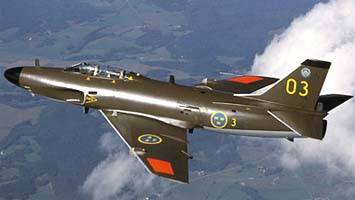
TTX
So, Saab 32 Lansen, in most versions, is a two-seat single-engine aircraft made according to a normal aerodynamic configuration with a low swept wing. Behind it, in the tail of the aircraft, there is a horizontal tail, represented by stabilizers with separate adjustable elevators, and a vertical tail, represented by one keel, with a separate rudder.
Above the wings, on either side of the fuselage, there are two semi-circular air intakes through which air passes into the only engine, which was the Rolls-Royce Avon and its licensed version of the Svenska Flygmotor RM.6 in Mk versions. 21, 47, 60 and 19R, with more power, which was supposed to be installed on the supersonic version of the Saab 32. Under the wings there are 6 hardpoints on each side and one more under the fuselage.
With performance characteristics and weapons, the devil himself will break his leg, but let's try to characterize it as popularly as possible and for all versions at the same time, although there will be additional clarifications. So:
Length: 14,94 m
Wingspan: 13 m
Height: 4,65 m
Wing area: 37,4 m2
Aerodynamic profile: NACA 64A010
Empty weight:
7 kg (A 438A)
8 kg (J 077B)
7 520 kg (S 32C)
Max takeoff weight:
13 kg (A 600A)
13 kg (J 500B)
12 500 kg (S 32C)
Maximum fuel weight:
Wings and body:
2 kg (800 liters)
Additional tank:
440 kg (600 liters) + 96 kg (tank)
Power point: 1 turbojet thrust 47 kN dry, 65,3 kN with afterburner
Performance:
Maximum speed: 1 114 km / h
Cruising speed: 988 km / h
Range: 2 km
Transport range: 1 km
Ceiling: 14 000 m
Rate of climb: 100 m / s
Fixed weapons:
Guns: 4 × 30mm ADEN cannons, 90 rounds each.
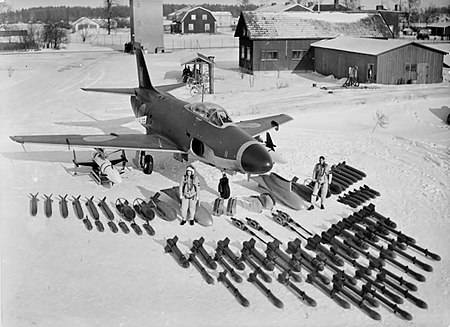
We will not dwell on missiles in detail, because in addition to this article I will post a fairly large table that will contain the necessary list of Saab 32 weapons.
I will do the same with the Saab 32 avionics, which I managed to advertise heavily in the course of the article. These are echoes of the fact that I did not share the article even more, but with an overview of each modification of the Swedish aircraft. So in the article, which will contain a table with weapons, there will also be a table with full avionics for each fighter model and a couple of tables on the little things.
The mechanization of the Saab 32 is quite complicated. For better landing characteristics, the wing has two-section slats and single-slotted flaps. The wingtips have ailerons with a fairly rigid trailing edge and relatively long trim tabs. The Saab 32 has a keel with a two-section separate rudder, consisting of two parts of different sizes. If I understand correctly, then this solution was applied for better controllability of the car. The stabilizers are equipped with separate elevators.
The landing gear of the aircraft is tricycle, with a front rotary support. The main racks are retracted into special grooves under the fuselage. In flight, they are completely closed. The main support retracts into the space under the cockpit in the opposite direction from the air flow. In flight, the main landing gear is also completely closed.
Now, it seems to me, we can proceed to the conclusion.
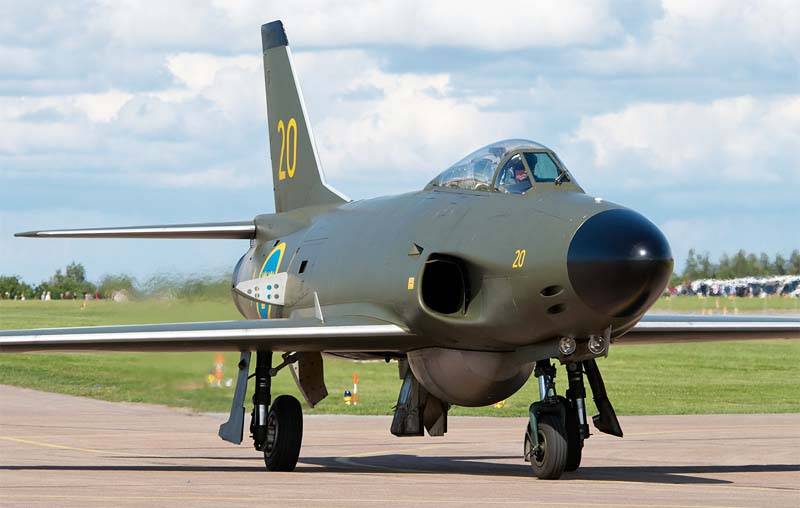
Hack and predictor Aviator
If we talk about the Saab 32 in a complex way, then this is one of the most underestimated projects from the world of aviation, among those that I got my hands on. It was a representative of the breed of universal machines that are able to effectively fulfill the role of an attack aircraft, a fighter, and a reconnaissance aircraft.
Fortunately, the issue of "efficiency" was resolved not by using the aircraft in another war, but due to the fact that it remained in service for a relatively long time, and, apparently, there were no complaints about this aircraft among the military. Of course, this fact is relative, and in Sweden there were, and still are, a lot of people who, for objective reasons, cannot like the Saab 32. We will talk about this in a separate article.
But be that as it may, this car was a very curious product of its time, which incorporated many interesting concepts of the recent past, relevant developments of foreign colleagues, and even managed to set the vector for the development of future Swedish cars. Thanks to this, he was something head and shoulders above, and not due to imaginary dominance over other fighters of a related generation. After all, as it was found out during the course of the article, the long time frame for the creation of the Saab 32 allowed it to be somewhere close to the first generation fighters in terms of characteristics, but absorbing the features of technologically more powerful machines, for example, a new radar location, thereby being ahead of such aircraft as MiG-17, Yak-25, F-86 and MiG-15.
This was the attractive feature of this machine, which, despite numerous delays in production, was in that place at that time, allowing the Swedish Air Force to remain competitive, without allowing any crazy war to happen, which during the Cold War could have taken place. . Meanwhile, the Saab 32 remained an aircraft that had never been used in a military conflict, although Sweden was actively involved in various troubles around the world.
One way or another, Saab 32 left its mark in the history of the Swedish state, although perhaps not as significant as Saab 35, 37 or 39, but it allowed this country to become head and shoulders above in matters of aircraft construction.
Information